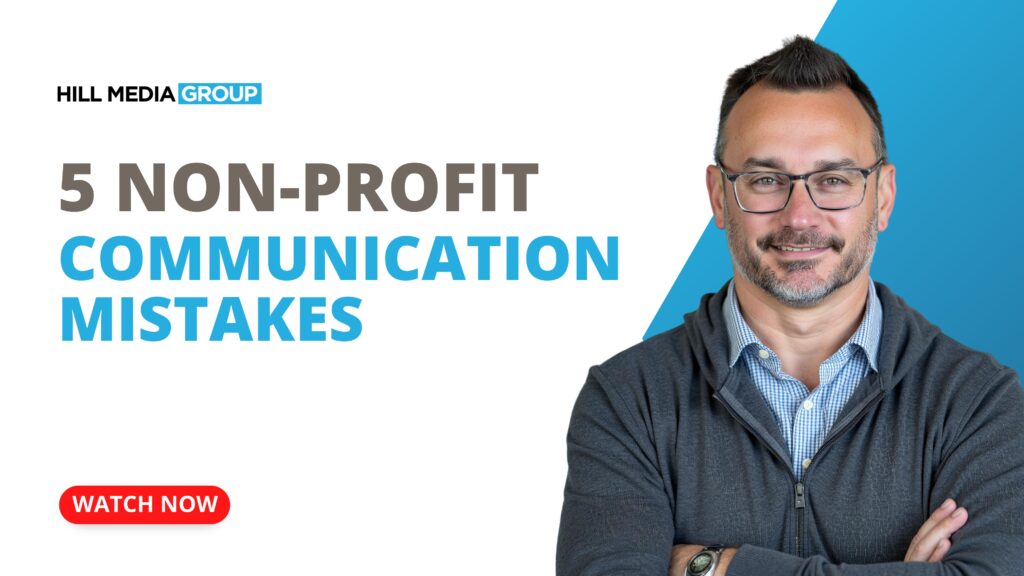Last year, I attended the annual fundraiser for a nonprofit I’ve supported for several years. I walked into that event expecting the usual energy and excitement; stories of impact, updates on programs, and that feeling of being part of something meaningful. Instead, I left feeling disconnected and confused.
The organization hadn’t sent a single email update all year except for donation confirmations. The only communication we received was the invitation to this annual event. As I sat at my table with other longtime supporters, we all admitted the same thing: we had no idea what the organization had accomplished in the past year. We were there purely because we trusted the executive director, but we felt an alarming lack of connection to the mission we’d been funding.
The event felt off. Attendance was noticeably lower than the previous year. And most concerning? The people who showed up, the most committed supporters, felt left in the dark.
This experience perfectly illustrates how communication failures can slowly erode even the strongest supporter relationships. If your most loyal donors and volunteers feel disconnected, imagine how those with looser ties to your organization must feel.
As a nonprofit leader, you’re probably thinking, “But communication is hard! We don’t have the resources to constantly update everyone.” You’re absolutely right, and that’s exactly why modern tools like automated email marketing and integrated CRM systems exist. They allow you to maintain meaningful connections without overwhelming your small team.
Let’s explore the five most common communication failures that cost nonprofits their most valuable supporters, and practical solutions that any organization can implement.
1. Lack of Clear and Consistent Communication
The Problem: Donors and volunteers need to understand their role in your mission, see the impact of their contributions, and receive regular organizational updates. When communication is unclear, inconsistent, or absent entirely, supporters feel lost and undervalued.
My nonprofit experience is a perfect example. Twelve months of silence followed by one overwhelming information dump at an annual event isn’t communication, it’s crisis management. When supporters don’t hear from you regularly, they begin to question whether their contributions matter or if your organization is even still active.
The Solution: Implement two foundational communication systems:
Welcome Series Email Automation: Create a 3-5 email sequence that automatically triggers when someone makes their first donation or signs up to volunteer. This series should introduce your organization, explain your mission, share recent impact stories, and set expectations for future communications.
Monthly Newsletter: 45% of nonprofits send newsletters monthly, and there’s good reason for this frequency. Monthly newsletters keep your organization top-of-mind without overwhelming supporters. Include program updates, impact stories, volunteer spotlights, and upcoming opportunities to get involved.
How to Set It Up: An integrated CRM and email marketing platform makes this simple. When someone donates through your website, they’re automatically added to your welcome series. After the series completes, they’re moved to your monthly newsletter list. No manual work required after the initial setup.
2. Failure to Show Appreciation
The Problem: Not thanking supporters or failing to acknowledge their contributions meaningfully is a major reason people stop supporting organizations. Simple gestures of gratitude can dramatically improve retention, yet many nonprofits only reach out when they need something.
Statistics support this: 55% of donors in the US prefer to be thanked for their contribution through email, and 74% of new subscribers expect welcome email after joining a newsletter and these messages have an average open rate of 202% higher than traditional email campaigns.
The Solution: Create systematic appreciation that goes beyond basic thank-you notes:
Volunteer and Donor Spotlights: Feature a different volunteer or donor each month in your newsletter. Share their story, why they support your cause, and the specific impact they’re making. This not only appreciates the featured person but shows other supporters they’re valued too.
Team Impact Updates: Showcase how donor support enables your team to create impact. Instead of generic “thanks for your donation,” explain specifically how recent contributions funded a program, supported a family, or advanced your mission.
How to Set It Up: Use tags in your CRM to identify different supporter types (new donor, recurring donor, volunteer, major donor). Set up automated thank-you emails that are tailored to each group, with personal touches that reflect their specific contribution.
3. One-Way or Transactional Communication
The Problem: Only reaching out when you need donations or volunteer hours creates fatigue and erodes relationships. Frequent, consistent communication with online donors results in a 41.5% increase in revenue, but this communication must provide value, not just make asks.
This is perhaps the most common mistake nonprofits make. Your supporters don’t want to feel like ATMs that you only approach when you need money.
The Solution: Implement interaction-based communication triggers:
Two-Way Email Engagement: Ask questions in your newsletters and respond to replies. Send surveys asking for feedback on programs or input on organizational decisions. Create email series that invite responses, such as “Share your volunteer story” or “What inspired you to support our cause?”
Segmented Communication Based on Engagement: Use your CRM to track different types of interactions, email opens, website visits, event attendance, and volunteer hours. Create automated email sequences that respond to these actions with relevant content.
How to Set It Up: When your CRM and email marketing system are connected, you can create tags for different interaction types. If someone opens emails consistently but hasn’t donated recently, they might receive impact stories and gentle giving opportunities. If someone volunteers regularly, they might get updates on volunteer appreciation events and program outcomes they directly supported.
4. Lack of Transparency and Impact Reporting
The Problem: Supporters want to know how their contributions make a difference. When organizations fail to communicate outcomes or how funds are used, trust erodes, and supporters are more likely to leave.
The timing of impact communication matters enormously. Sharing impact stories only when you’re about to ask for more money feels manipulative. Supporters can sense when appreciation and impact updates are just the setup for an ask.
The Solution: Share impact consistently throughout the year:
Regular Storytelling: Use email newsletters and social media to share impact stories quarterly, separate from fundraising campaigns. Capture photos and short videos during program activities. Supporters don’t expect studio-quality production; they want to feel involved and included.
Specific Impact Metrics: Instead of saying “your donation helps,” explain exactly what specific dollar amounts accomplish. “Your $50 donation provided school supplies for two children for an entire semester” is much more powerful than generic impact statements.
How to Set It Up: Build impact documentation into your program delivery. Train staff to capture photos and brief impact stories during regular activities. Store these in your CRM connected to specific programs or donation amounts, so you can easily pull relevant stories for different supporter segments.
5. Ignoring Audience Preferences and Failing to Personalize
The Problem: Using wrong communication channels or sending generic messages that don’t resonate with your audience leads to frustration and disconnection. Donor retention increases by 29% for offline donors when you have their email address, and emails with personalized subject lines are 26% more likely to be opened.
Not all supporters are the same. A monthly recurring donor should receive different communications than someone who made one donation six months ago. A hands-on volunteer should get different updates than a financial supporter who can’t volunteer time.
The Solution: Implement preference-based segmentation:
Automated Segmentation: Use your integrated CRM to automatically categorize supporters based on their giving history, volunteer involvement, and engagement level. Create email tracks for different supporter types: new supporters, recurring donors, active volunteers, major donors, and lapsed supporters.
Preference Collection: Ask supporters about their communication preferences during signup and in periodic surveys. Some want detailed program updates, others prefer high-level impact summaries. Some want monthly contact, others prefer quarterly.
How to Set It Up: An integrated CRM connected to your donation forms automatically captures the information needed for smart segmentation. When someone makes a donation, their giving level, frequency, and history automatically determine which email track they enter. You can also use simple surveys to gather communication preferences and update their profile accordingly.
The Technology That Makes It All Work
These solutions might sound complex, but the right technology makes them surprisingly simple to implement. Here’s what you need:
Integrated CRM and Donation Platform: Your donor management, online giving, and email marketing should work together seamlessly. When someone donates online, their information should automatically update in your CRM and trigger appropriate email sequences.
Website Integration: Your website should connect to your CRM so that newsletter signups, volunteer applications, and donation forms all feed into the same system.
Email Marketing Automation: You need the ability to create automated email sequences that trigger based on specific actions or timelines.
The key insight is that these aren’t separate tools; they’re components of an integrated system that works together. When properly connected, this system handles most of your communication automatically while allowing you to maintain personal touches where they matter most.
Getting Started: The First Step
Don’t try to implement everything at once. Start with the biggest gap in your current communication strategy. For most nonprofits, this is either the lack of regular newsletters or the absence of automated thank-you sequences.
Choose one solution from this article and implement it fully before moving to the next. Remember: 48% of donors cite email as their preferred method of hearing updates and appeals from the organization. Your supporters want to hear from you; they just want the communication to be valuable, timely, and relevant.
The nonprofit I mentioned at the beginning could have prevented their communication breakdown with just two simple systems: a monthly newsletter and an automated thank-you series. Their supporters were ready to be engaged; they just needed the organization to make the effort.
Communication failures don’t happen overnight, and neither does recovery. But with the right systems in place, you can transform supporter relationships from transactional to meaningful, ensuring that your most valuable advocates never feel left in the dark again.
Ready to transform your nonprofit’s communication strategy?
Every nonprofit deserves supporters who feel connected, appreciated, and engaged with your mission. If you’re ready to build communication systems that work automatically while strengthening relationships, let’s talk.
Schedule a free 15-minute Digital Growth Strategy Session and discover how an integrated CRM, donation platform, and email marketing system can keep your supporters engaged year-round, without adding to your team’s workload.
Because your mission is too important to lose supporters due to communication failures.




